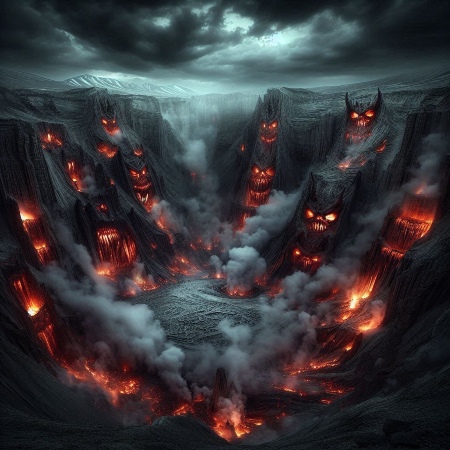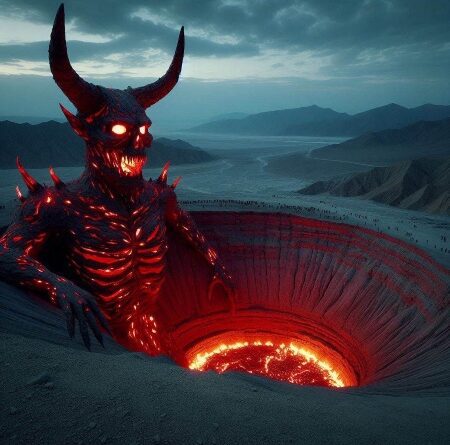Hell Below Earth: Meet Darvaza Gas Crater, “Gates Of Hell”
The name “Turkmenistan” does not mean much to the average traveler. Geography (and trivia) lovers may know that this is a country in the heart of the Asian continent. Turkmenistan is a relatively new country, which has over 6 million inhabitants – most of them are Muslim. But could it be that this country is the gate to hell? Darvaza Gas Crater, located near the village of that name, is one of the most unique and terrifying places in Asia. His common nicknames, “The Gate To Hell” or “The Door To Hell”, explain why. How else can you call a hole with a diameter of about 70 meters and a depth of about 20 meters, where a fire has been burning for more than five decades?
What Is Darvaza Gas Crater?
The truth is that it is difficult to define the Turkmenistan Gate of Hell as a natural site. The first question you may ask is where are the Gates Of Hell exactly? Well, Darvaza Gas Crater location is in the heart of the Karakum desert, which is a significant part (about 70%) of the territory of Turkmenistan. This is an almost uninhabited area, as evidenced by the fact that, on average, you will find only one person per 6.5 square kilometers.
This desert is located about 260 kilometers north of the capital of Turkmenistan, Ashgabat. It is characterized by extreme temperatures. Turkmenistan is the hottest country in Central Asia, and in the summer the temperature in the desert area reaches about 50 degrees Celsius. The winters, as befits the climate we are talking about, are particularly freezing with temperatures that can drop to around -20 degrees Celsius.
In Darvaza Gas Crater, needless to say, the temperatures are much higher than anything we know. The fact that the fire burns here continuously for a very long time means that the heat in it is about six times higher than the highest air temperature ever measured on Earth. The temperature inside Darvaza Gas Crater is about 400 degrees Celsius. That’s why the residents decided over time to call this site, located right in the heart of the desert, the “Gate of Hell”. Some people believe this is one of the entry points to hell, which was “accidentally” uncovered over the years.

How Did The Darvaza Gas Crater Start?
It is important to note that it is not yet fully known how exactly Gates Of Hell Crater was created and ignited. To add to the mystery of the place, relevant records do not exist in the archive or are classified as inaccessible. The common perception is that the circumstances that led to its formation, and explain why a fire has been burning here continuously since 1971 (!), are anything but natural.
To understand how Turkmenistan Gates Of Hell was created, at least according to one of the concepts, we go back a few decades. In 1971, Soviet geologists performed routine drilling into an underground space, in an attempt to locate the natural gas deposits that the area is known for (in fact, little Turkmenistan ranks sixth in the world in the number of natural gas reserves it has). Due to the pressures, the cave’s roof collapsed on top of the excavation equipment.
 When the researchers realized that the crater contained large amounts of toxic methane gas, which today is known as a main cause of global warming and the ecological damage that accompanies us, they decided to explode it. Their belief, or perhaps hope, was that the gas would burn itself out after a few days so that they could return and retrieve their valuable equipment. In practice, they were wrong in their assessment – big time. More than five decades have passed since then, and the gas continues to burn.
When the researchers realized that the crater contained large amounts of toxic methane gas, which today is known as a main cause of global warming and the ecological damage that accompanies us, they decided to explode it. Their belief, or perhaps hope, was that the gas would burn itself out after a few days so that they could return and retrieve their valuable equipment. In practice, they were wrong in their assessment – big time. More than five decades have passed since then, and the gas continues to burn.
Another theory is that the collapse of the crater occurred as early as the 1960s, possibly due to natural geological causes. Even in this theory, the reason for that eternal flame is the burning of the crater, in the 1980s, to prevent the emission of toxic gases.
The Gates Of Hell Crater As Research Site
In the decades since then, Darvaza Gas Crater Turkmenistan has served as a research center. In 2013, for example, a researcher named George Kourounis was the first to go down to the bottom of the Darvaza Gas Crater. He was equipped with a fire protection suit and a harness and collected soil samples. One of the main conclusions of the expedition, which was partially funded by National Geographic, was that it is impossible to fully determine when and how the flare-up began.
The expedition also revealed unique life forms, which surprisingly actually managed to exist or even thrive in the hellish conditions here. These creatures are “extremophiles”, that is, living creatures (mainly bacteria and archaeons) that live precisely in extreme environmental conditions. In this case, the organisms learned to thrive in the complex environment of the Gates Of Hell Turkmenistan, characterized of course by high temperatures and minimal nutritional conditions.
And speaking of animals, according to evidence this is a mass “suicide” site of… spiders. At night, hordes of spiders make their way to the heart of the flames and end their lives there. A common explanation of the Darvaza Gas Crater Spiders phenomenon is their natural attraction to the bright light of the flames, which is contrasted with the total darkness of the desert.

How Long Will The Darvaza Gas Crater Burn?
Over the years, the thought of using the technology and knowledge gained since then to close the Darvaza Gas Crater Turkmenistanhas, or at the very least to reduce its ecological and environmental impact (for example, it makes it difficult to establish other natural gas fields in its vicinity) came up more than once. Ruler Turkminstone Gurbanguly Berdimuhamedov announced, somewhere in 2010, an attempt to eradicate Turkmenistan’s Darvaza Gas Crater, but nothing significant was done.
At the beginning of 2022, Berdimuhamedov announced again his intention to close the well to increase the income from exporting natural gas, reduce the Darvaza Gas Crater environmental impact, and prevent possible damage to humans, who may be harmed when exposed to the toxic gas. A committee was established that should decide on the most effective and safest way to make that gate to hell disappear, if this is possible. At this point, we are not sure when will the Darvaza Gas Crater stop burning.
Is It Possible To Reach Turkmenistan Gates Of Hell?
The government of Turkmenistan is not too proud of this crater and is not too happy to receive tourists. And yet, for some reason, its dictator chose to fake the rumors of his death, which spread in 2019 after not being seen in public for several weeks, by visiting the Turkmenistan Darvaza Gas Crater. Berdimuhamedov filmed himself driving a race car around the pit and even playing bowling because these are exactly the things people do to prove they are alive.
Like other natural places that pose a danger to those who dare to visit them, curiosity seems to play a role here. In post-Soviet Turkmenistan, this crater is the most famous site. It has also become a highly sought-after tourist attraction, partly because the entire area was declared a nature reserve in 2013. But if you were thinking of visiting here, think again.
Although travelers can practically visit Turkmenistan after obtaining a visa (not necessarily an easy task) and being accompanied by a local guide, it should be remembered that Turkmenistan is an almost hermetically sealed country that only opens its doors to a fairly small percentage of foreign tourists. Some of them manage to reach the gates of hell with local guides, who know how to navigate to it even though, naturally, there are no signs, and the GPS Apps won’t help either. The estimations are that tens of thousands of people annually make their way to the pit. Others prefer to be cautious and watch it from a relatively “safe” distance: at night, you can see the flames from a distance of about 40 kilometers.





